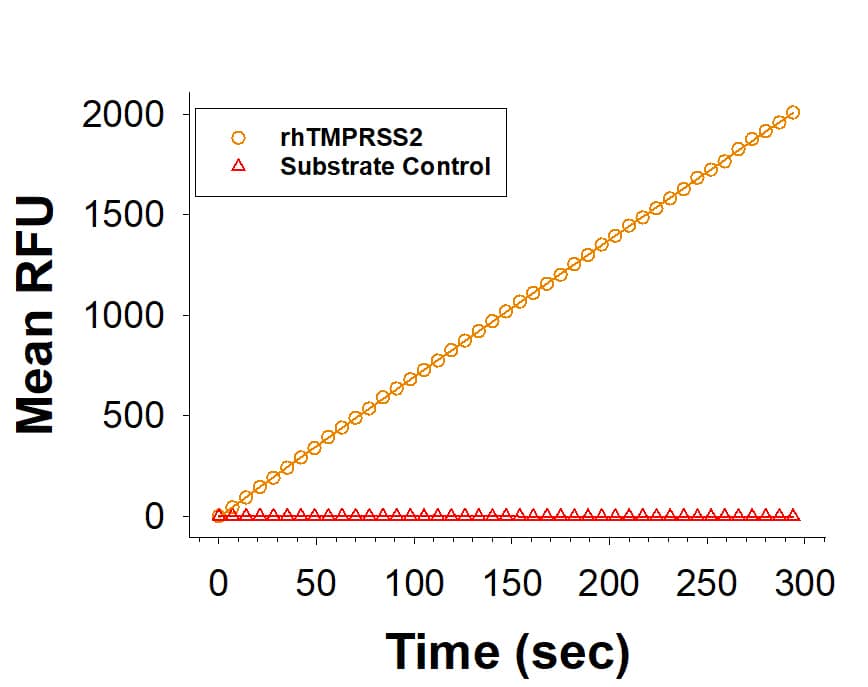Recombinant Human TMPRSS2 His-tag Protein, CF Summary
Product Specifications
Trp106-Gly492, with modifications in the non-catalytic chain and a C-terminal 6-His tag
Analysis
Product Datasheets
Carrier Free
CF stands for Carrier Free (CF). We typically add Bovine Serum Albumin (BSA) as a carrier protein to our recombinant proteins. Adding a carrier protein enhances protein stability, increases shelf-life, and allows the recombinant protein to be stored at a more dilute concentration. The carrier free version does not contain BSA.
In general, we advise purchasing the recombinant protein with BSA for use in cell or tissue culture, or as an ELISA standard. In contrast, the carrier free protein is recommended for applications, in which the presence of BSA could interfere.
11457-TP
| Formulation | Supplied as a 0.2 μm filtered solution in MES and NaCl. |
| Shipping | The product is shipped with dry ice or equivalent. Upon receipt, store it immediately at the temperature recommended below. |
| Stability & Storage: | Use a manual defrost freezer and avoid repeated freeze-thaw cycles.
|
Assay Procedure
- Assay Buffer: 50 mM Tris, 50 mM NaCl, 0.01% Tween-20, pH 9.0
- Recombinant Human (rhTMPRSS2) TMPRSS2 His-tag (Catalog # 11457-TP)
- Substrate: BOC-Gln-Ala-Arg-AMC (Catalog # ES014), 10 mM stock in DMSO
- Black 96 well Plate
- Plate Reader with Fluorescence Read Capability
- Dilute rhTMPRSS2 to 0.1 µg/mL in Assay Buffer.
- Dilute Substrate to 400 µM in Assay Buffer.
- Load into a plate 50 µL of 0.1 µg/mL rhTMPRSS2, and start the reaction by adding 50 µL of 400 µM Substrate. Include a Substrate Blank containing 50 µL of Assay Buffer and 50 µL of 400 µM Substrate.
- Read at excitation and emission wavelengths of 380 nm and 460 nm (top read), respectively, in kinetic mode for 5 minutes.
- Calculate specific activity:
Specific Activity (pmol/min/µg) = | Adjusted Vmax* (RFU/min) x Conversion Factor** (pmol/RFU) |
| amount of enzyme (µg) |
- rhTMPRSS2: 0.005 µg
- Substrate: 200 µM
Scientific Data
 View Larger
View Larger
Recombinant Human TMPRSS2 His-tag Protein (Catalog # 11457-TP) is measured by its ability to cleave the fluorogenic peptide substrate Boc-QAR-AMC (ES014).
Reconstitution Calculator
Background: TMPRSS2
Recombinant Transmembrane protease serine 2 (TMPRSS2), also referred to as serine protease 10 (PRSS10), is a member of the type II transmembrane serine protease (TTSP) peptidase S1 family (1). Similar to other members of the TTSP family, TMPRSS2 is produced as a zymogen and undergoes post-transcriptional modifications to allow proteolytic autoactivation into a non-catalytic chain, composed of an LDLR-A and SRCR domain, and a catalytic chain with a highly conserved serine protease (SP) domain. The TMPRSS2 SP domain uniquely contains an unpaired cysteine bordered by a hydrophobic patch thought to accommodate various binding partners (2). TMPRSS2 consists of three distinct regions, including an intracellular domain, a single-pass transmembrane domain, and an extracellular domain and can be membrane bound or found in a soluble secreted form (1, 2). The TMPRSS2 gene harbors androgen-responsive elements and expressed through the stimulation of the AR (1) in tissues with epithelial cells at high levels in prostate and relatively lower levels of expression in lungs, colon, liver, kidneys and pancreas (2-4). TMPRSS2 activates protease activated receptor 2 (PAR-2), a G-protein coupled receptor, causing the upregulation of matrix metalloproteinase-2 and -9, key proteases in the metastasis of tumor cells (5) and in prostate cancer has been shown to activate pro-hepatocyte growth factor resulting in subsequent c-MET signaling known to regulate the tumor microenvironment, immune infiltration, and immune response (6,7). TMPRSS2 expression may be involved broadly in cancer prognosis through this pathway as reported in lung adenocarcinoma and breast invasive carcinoma (7). In addition to playing a role in cancer, TMPRSS2 is the host protease determined to be responsible for processing of viral protein to facilitate host entry in several viruses including spike protein in SARS-CoV-2, SARS-CoV, and MERS-CoV and hemagglutinin in influenza A viruses (3,4,8-11). TMPRSS2 represents a prime target for therapeutic intervention in aggressive cancers and to block initial viral influenza and coronavirus infection (2, 3, 11).
- Gioukaki, C. et al. (2023) Int. J. Mol. Sci. 24:11299.
- Fraser, B.J. et al. (2022) Nat. Chem. Biol. 18:963.
- Shen, L.W. et al. (2017) Biochimie142:1.
- Sarker, J. et al. (2021) Scientifica doi: 10.1155/2021/2706789. (PMID 36336361).
- Lucas, J.M. et al. (2014) Cancer Discov. 4:1310.
- Zambeli, A. et al. (2021) Adv. Exp. Med. Biol. 1270:31.
- Xiao, X. et al. (2022) Front. Mol. Biosci. 9:647826.
- Abe, M. et al. (2013) J. Virol. 87:11930.
- Sakai, K. et al. (2014) J. Virol. 88:5608.
- Zmora, P. et al. (2015) PLoS One 10:e0138380.
- Bestle, D. et al. (2020) Life. Sci. Alliance 3:e20200786.
FAQs
No product specific FAQs exist for this product, however you may
View all Proteins and Enzyme FAQsReviews for Recombinant Human TMPRSS2 His-tag Protein, CF
There are currently no reviews for this product. Be the first to review Recombinant Human TMPRSS2 His-tag Protein, CF and earn rewards!
Have you used Recombinant Human TMPRSS2 His-tag Protein, CF?
Submit a review and receive an Amazon gift card.
$25/€18/£15/$25CAN/¥75 Yuan/¥2500 Yen for a review with an image
$10/€7/£6/$10 CAD/¥70 Yuan/¥1110 Yen for a review without an image
